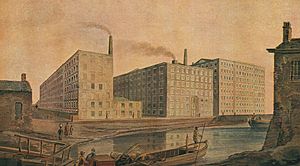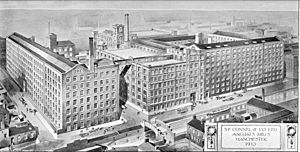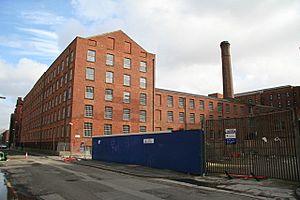Ancoats facts for kids
Quick facts for kids Ancoats |
|
|---|---|
 Ancoats is a former industrial district being gentrified as a residential area. |
|
| OS grid reference | SJ847985 |
| Metropolitan borough | |
| Metropolitan county | |
| Region | |
| Country | England |
| Sovereign state | United Kingdom |
| Post town | MANCHESTER |
| Postcode district | M4 |
| Dialling code | 0161 |
| Police | Greater Manchester |
| Fire | Greater Manchester |
| Ambulance | North West |
| EU Parliament | North West England |
| UK Parliament |
|
Ancoats is an area in Manchester, England. It's located right next to the Northern Quarter, which is the northern part of Manchester city centre.
Long ago, Ancoats was part of Lancashire. It became a very important place during the Industrial Revolution. Some people even call it "the world's first industrial suburb" because so many factories and mills were built there. From the late 1700s, Ancoats was a busy industrial area. However, from the 1930s onwards, the area faced tough economic times. Many people moved away, especially in the 1960s when old houses were replaced with new developments.
Since the 1990s, people have started to appreciate Ancoats' amazing industrial heritage. Because it's so close to the city centre, a lot of money has been invested to rebuild and improve the area. The southern part of Ancoats was even given a new name, New Islington, by a company called Urban Splash. This redevelopment focused on the Daily Express Building.
In 2021, a special sign was put up to show that Ancoats was once known as a Little Italy, due to many Italian families living there.
For local elections, Ancoats is part of the Ancoats and Beswick ward on Manchester City Council.
Contents
History of Ancoats
Early Times in Ancoats
The name Ancoats probably comes from old English words meaning "lonely cottages." The area was first mentioned in records in 1212 as Elnecot. In 1320, Ancoats was listed as one of eight small villages, or hamlets, within the larger area of Manchester. It likely had just a few cottages and farmhouses. During the Middle Ages, a building called Ancoats Hall was built there. The village was located between the River Medlock and the River Irk.
Ancoats and the Industrial Revolution
Cotton Mills in Ancoats
In 1765, James Brindley surveyed the land for the Rochdale Canal. Knowing that the canal would make it easier to move materials and finished goods, business owners felt confident building cotton mills. The first mills in Ancoats appeared as early as 1790. By the late 1700s, steam power was used to run the cotton mills. Some of the earliest mills were Murray's Mills, built by Adam and George Murray in 1798. These mills were located next to the Rochdale Canal. Later, they became known as Ancoats Mills. The streets of Ancoats were also planned out during this time.
After the Rochdale Canal opened in 1804, many more mills were built. Famous mills in Ancoats included Victoria Mills, Wellington Mill, Brunswick Mill, Beehive Mill, Royal Mill, and Pin Mill.
Ancoats grew very quickly and became a major industrial hub. This also meant it became a very crowded place. By 1815, Ancoats had more people than any other district in Manchester. Many small, closely packed houses were built. For the poorest people, houses were even split up, and cellars were rented out separately. Public health was a big worry. A survey, done because people feared a cholera outbreak, showed that over half the homes in Ancoats didn't have their own plumbing. Also, more than half the streets were not cleaned.
By the mid-1800s, Ancoats was very developed. In 1851, its population was 53,737, which was larger than many towns. However, despite so many people, Ancoats didn't have many public buildings or green spaces. There were no parks, and the only public buildings were a few churches and a small clinic.
Factories and Machines
Cotton wasn't the only industry here. Factories that made machines and metal parts were also needed for the mills. The largest of these were run by brothers John Muir Hetherington and Thomas Ridley Hetherington, starting in 1830. Their main factory was called Vulcan Works. Their company made a huge variety of machines for the textile industry. These machines helped with cleaning, spinning, and preparing cotton, wool, and other materials.
Glass Making in Ancoats
One less known but very important industry in Ancoats was making flint glass. More than 25 glassworks were built in Manchester during the 1800s, and many of them were in Ancoats. One factory, started by Thomas Percival and William Yates in 1844, made many types of glassware. This included drinking glasses, wine glasses, and vases. One of the old glass-making buildings, the Flint Glass Works, still exists today. It has been turned into offices.
Other Industries
Ancoats also had other businesses. There was a large factory that supplied rock salt and other materials. There were also chemical factories, places that made floor coverings, and finishing works that rolled cloth to make it smooth or shiny.
Ancoats in Victorian Times
New People Arrive
During the 1800s, many Italians left Italy to find a safer life. Most of the Italians who came to Ancoats were from areas like Liguria and Frosinone. Over the next hundred years, they created what became known as Ancoats Little Italy. Many Irish people also moved to Ancoats. The 1851 census showed that almost half the men living in Ancoats were born in Ireland.
Helping the Community
Towards the end of the 1800s, the Methodists were very active in Ancoats. They ran places that helped men and women in need. While there were many pubs, only a few buildings remain today, and only two are still open. The Salvation Army also had a presence in Ancoats, with the Star Hall and Crossley Hospital. Today, flats belonging to the Salvation Army are on that site. Ancoats Hospital was on Old Mill Street. It is now being turned into homes. In 1886, Thomas Horsfall opened the Manchester Art Museum, a free art gallery. He wanted to give people a positive alternative to pubs.
Because so many Irish and Italian people moved to Ancoats, a large number of its residents were Roman Catholic. Many Italians who settled in Ancoats became successful in business. For example, the Ronchetti family made glasses and instruments, and J. L. Casartelli was also an instrument maker and chemist.
Ancoats in the 20th Century
In 1910, a company called Avro set up a factory in Brownsfield Mill in Ancoats. Here, they built aircraft. Soldiers from Ancoats fighting in France during the First World War would see planes flying above them and know they were made back home in Ancoats.
In 1939, the Daily Express newspaper company opened a new building in Ancoats. It was built in a modern style, similar to their famous building in London.
Changes After the Wars
The busy activity from all the mills slowed down when the cotton industry faced problems in the 1930s. After that, the mills became less successful. The only new industry to arrive in Ancoats was newspaper printing. Ancoats, like nearby areas, became very run down. Cotton spinning stopped in Manchester, and the mills were used for other things, like making clothes, repairing machines, and storing imported goods.
The 1960s saw more changes. Many old terraced homes were cleared, and people moved to new houses in other parts of the city. The mills, which were getting less money from rent, started to fall apart.
Even though many old houses were removed in the early 1960s, and most families moved to new housing estates, the local council built many new houses and flats in Ancoats. However, the population was still lower by 1970 because the new homes were more spread out.
Newspaper printing, one of Ancoats' newer industries, also changed due to new technology. The Daily Express stopped printing from its famous black glass building in 1989. This closure, however, also marked the start of Ancoats' renewal. People began to realize the problems caused by low investment and rising unemployment.
Ancoats Today: A New Beginning
In June 1989, Manchester City Council made a part of Ancoats a conservation area. This meant that many historic buildings were protected. While this helped preserve history, it also made redevelopment a bit harder. In 1990, the Eastside Regeneration group was formed to help rebuild the area. This led to the creation of other groups focused on Ancoats' future. In the early 1990s, Manchester tried to host the Olympics, which caused some people to buy property in Ancoats hoping prices would go up. When the Olympic bids failed, these buildings were left empty and decayed even faster. By 1998, it was thought that 80% of business spaces in Ancoats were empty.
In 2000, the government approved the £250 million New Islington Project. This project aimed to redevelop a large section of land between the Rochdale and Ashton Canals. To help with this, a special order was made to buy land in the area, preventing people from buying it just to make a quick profit. A goal was set to have 15,000 people living in Ancoats by 2010.
Famous Places in Ancoats
Here are some important buildings in the Ancoats conservation area:
- Beehive Mill, Jersey Street. Built between 1820-24. It's a Grade II* listed building, meaning it's very important.
- Brownsfield Mill, Great Ancoats Street. Built around 1825. Also Grade II*.
- Church of St. Peter, Blossom Street. Designed in 1859–60. Grade C.
- Crown and Kettle public house, Oldham Road. Built in the early 1800s. Grade II.
- Daily Express Building, Great Ancoats Street. Designed in 1939. Grade II.
- Jersey Mill, Jersey Street. Built in 1804. Grade II*.
- Mill at Redhill Street/Bengal Street. Built in the early 1800s and 1842. Grade II*.
- Murray's Mill (main block), Redhill Street. Built in 1798. Grade II*.
- Murray's Mill, Murray Street. Built around 1800. Grade II.
- Paragon Mill, Jersey Street. Built around 1912. Grade II*.
- Royal Mill, Henry Street. Built around 1912. Grade II*.
- Sedgwick Mill, Redhill Street. Probably designed in 1818. Grade II.
- Sedgwick New Mill, Redhill Street. Built around 1858. Grade II.
- Victoria Square, Oldham Road. Designed between 1889–1894. Grade II.
- St Michael's RC church, built around 1869.
Culture and Arts in Ancoats
- Hallé St Peter's is a place where the famous Hallé Orchestra practices and holds educational events. It's located in the old St Peter's Church on Blossom Street.
- Sankeys nightclub used to be in Beehive Mill. It closed in 2018.
- Hallé St Michael's, a community space for the Hallé's artistic and educational activities, is on George Leigh Street.
People from Ancoats
- Hugh Oldham (1452–1519) was a Bishop who was born in Ancoats. He helped start Manchester Grammar School and was a major supporter of Corpus Christi College, Oxford.
- Richard Buxton (1786–1865) was a shoemaker from Ancoats who loved plants. He published a guide to the plants around Manchester in 1849.
- William Hepworth Dixon (1821–1879) was a historian and travel writer born in Great Ancoats.
- John Sibbit (1895–1950) was a British track cyclist who won a silver medal at the 1928 Summer Olympics.
- Bernard Manning (1930–2007) was a stand-up comedian.
- Foo Foo Lammar (1937–2003) was a famous drag queen. She was born in Ancoats.
- John Henshaw (born 1951) is an actor, known for playing Ken, the pub landlord in the TV series Early Doors.






